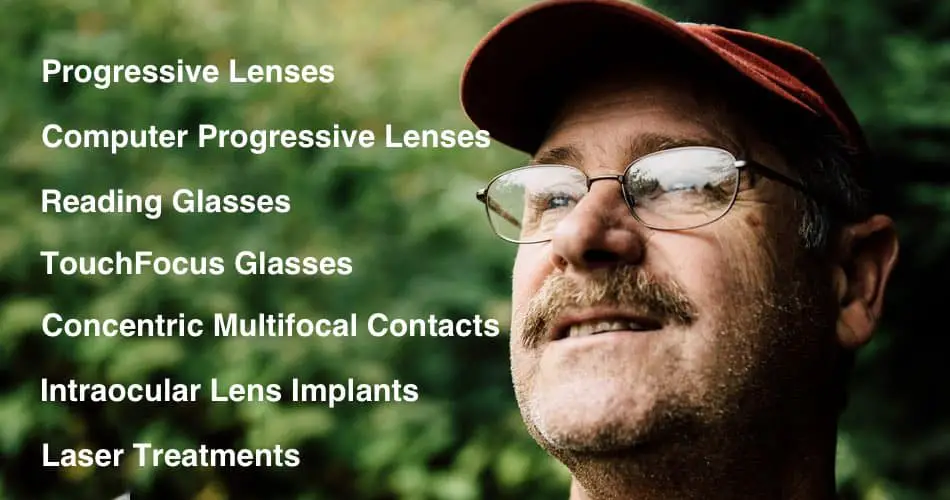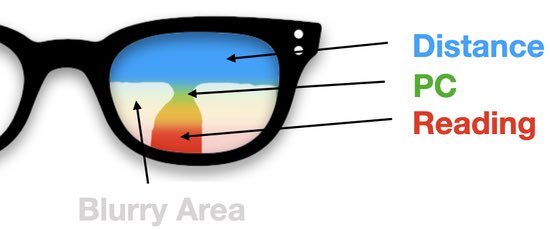Whether you have astigmatisms, are farsighted or nearsighted, or have presbyopia, you may have the inability to see very close or far away, or both. These eye conditions cause your eyes to need correcting lenses to fix your vision so you can see, like in bifocals. However, some people may not want to wear bifocals as they cause a head-swimming feeling that no one likes.
Read on to find 25 of the best alternatives to bifocals, including glasses, contacts, and corrective surgeries, so you can improve your ability to see, and most importantly, you can be comfortable with your vision-corrections.

Should I Switch from Bifocals?
Though bifocals are made to help vision, they may worsen the side-effects of poor vision in some cases. It takes time to adjust to bifocals. The blunt separating line dividing the nearsighted and farsighted view causes blurry sight, lack of depth perception, a head-swimming feeling, headaches, and even nausea.
Patients who have used bifocals say that it is hard to look down when wearing bifocals, especially when your lens power is different for each eye. And you must constantly look forward if you want to read up close. Strain in the neck can form when you have to hold your head in an awkward position to read with bifocals. It can also be hard to walk downstairs because you have to look down to see where you’re walking.
Progressive Lenses
Progressive lenses are a step-up from bifocals. Also known as no-line trifocals, progressive lenses offer three different views in a gradual transition with seamless line-free lenses. There are several different types of progressive lenses, which are listed below.

Standard Progressive Lenses
Standard progressive glasses or multifocal glasses, unlike bifocals and trifocals, do not have a separating line or lines in the lenses. Similar to trifocals, they provide a transition from farsighted to intermediate to nearsighted view; however, they are smoother and more seamless. Progressive lenses are great if you don’t want to spend all your extra time switching around your glasses.
Although theoretically you have the lens power for every distance you want to see clear in, most people have an additional pair of glasses for maximum comfort.
Photochromic Progressive Lenses
Photochromic progressive lenses, or progressive transition lenses, are light-adaptive lenses that provide shade from the bright sun while giving you the same features as standard progressive glasses. Photochromic lenses work with ultraviolet radiation-activated molecules that get darker when exposed by the sun’s UV rays. These glasses are best used daily for better vision.
Computer Progressive Lenses
If you are farsighted and work in a profession where you are on the computer for more than four hours a day, then computer progressive lenses are for you. These lenses can also help those who have to see up-close details, such as painters and librarians. These lenses are specifically designed for clear vision 16 inches from the face and are better than bifocals when it comes to looking at your desktop PC.

But of course, they are just made to be used in the room. You will see blurry if you take them outside.
Premium Progressive Lenses
Premium progressive lenses make the most high-quality glasses for those with eye conditions such as higher presbyopia. Using wave-form technology, these lenses have a broader segment that provides readability with no distortions for the best vision. Eyeglasses with these lenses can be custom-made to your prescription and preferred style of frames for guaranteed satisfaction.
Short Corridor Progressive Lenses
Short corridor progressive lenses are designed to fit smaller glasses frames. They allow you to see far, intermediate, and near distances seamlessly while remaining stylish. But the intermediate section will be compromised. The shorter you go with the progressive lenses the faster the transition has to happen from the reading area into the section for distance vision.
They are recommended when your prescription is different in your left and right eye to minimize side effects.
Long Corridor Progressive Lenses
Long corridor progressive lenses provide all of the same abilities short corridor progressive lenses do, but they are designed with a wider field of view. The longer the corridor is the wider your field of view will be.
Ground-View Progressive Lenses
With regular progressive lenses, the up-close vision segment makes your vision blurred when looking down; looking straight ahead to read is better. However, with ground-view progressive lenses, you can look down with clear vision. For those who enjoy outdoor activities such as golf, where you have to keep your eye on the ball, glasses with ground-view lenses are perfect.
Other Eyeglasses Options
Besides bifocals, there are different kinds of glasses to help sight. Some of these glasses are more convenient, some with smart technology, and some provide custom qualities to fit your vision and glasses style. These eyeglasses are specially designed with lenses to help those with vision impairments such as astigmatisms, myopia, hyperopia, or presbyopia.
Reading Glasses
Patients with presbyopia, also known as farsightedness due to age, may struggle to read things when they’re up too close. If you have otherwise perfect vision besides blurred vision up close, reading glasses might be helpful. To find the right strength for your reading glasses to improve your sight, you can find cards online consisting of different sized texts to strength ratios.

Standard Trifocal Glasses
Trifocal glasses, unlike bifocals, contain three different distance views. Bifocals only have an abrupt cut-off between the nearsighted and farsighted view separated by a line in the lens. Trifocals have both nearsighted and farsighted segments, including an additional intermediate section in between for a more comfortable transition.
This is oftentimes needed if you have a stronger reading segment. This is the case when your Add value is higher than 2 diopters.
Clip-On Glasses
Clip-on or snap-on glasses are magnetic additives to glasses frames for easy and convenient use. If you’re using your regular prescription clip-on and need to read something up close, you can quickly change them to your reading prescription. Clip-on glasses have options for farsightedness, nearsightedness, regular glasses, and sunshades.
TouchFocus Glasses
Made by a widely operated Japanese company, the high-tech and innovative TouchFocus glasses provide a better vision for you. The battery-operated technology condensed into the frames allows you to see far or near with just the touch of a sensor. TouchFocus glasses have 20 different frame options to choose from for your guaranteed satisfaction.
Multifocal Contact Lenses
Multifocal contact lenses provide different views of sight without the need for glasses. If you don’t like eyeglasses, then multifocal contact lenses might be the right option for you. There are a few different types of multifocal contact lenses, which are listed below.
Concentric Multifocal Contact Lenses
Concentric multifocal contact lenses have two different prescriptions with defining rings, so the transition from near to far vision is smoothly segmented. Depending on your prescription, the contact’s center can be focused on a nearsighted or farsighted view while the surrounding rings have the opposite power. This contact lens design allows you to see both near and far clearly.
Aspheric Multifocal Contact Lenses
Like concentric multifocal contact lenses, aspheric multifocal contact lenses provide vision in distances from near, intermediate, and far. However, these contact lenses don’t have the same distinct rings and instead have a smooth, gradual transition between the distance views. The center of these contacts can either be focused with a near or far point of view.
Progressive Multifocal Contact Lenses
Much like progressive lenses in glasses, progressive multifocal contact lenses provide a seamless transition between far, intermediate, and close distances without an abrupt separating line. Some contact lens brands alternate the power of the rings for optimal pupil coverage. If you have any eye conditions such as presbyopia or astigmatisms, then these contacts can be a good choice.
Usually what you need to know with multifocal contacts is you can expect a loss in contrast compared to your glasses. When light conditions are great this is no problem. The problems usually come up at night with multifocal contacts. So many of my customers only wear them in addition to their glasses.
Segmented Multifocal Contact Lenses
Like bifocal or trifocal glasses, segmented multifocal contact lenses have a distinct separation between farsighted and nearsighted vision. The bottom of these contact lenses is flattened to prevent rotation for the best vision possible. These contact lenses would be great for you if you like how trifocal glasses improve your sight but don’t like the look of glasses.
Other Contact Lenses Options
Those aren’t the only kinds of contact lenses that could fit your needs. Contact lenses made with monovision technologies are designed especially for those who may need bifocals but would rather not wear glasses. You can look like yourself and have improved vision by wearing these contact lenses without the uncomfortable fit of glasses.
Monovision Contact Lenses
Monovision contact lenses provide a unique sense of sight; the wearer has a nearsighted contact lens in one eye and, in the other, a farsighted contact lens. When your eyes work together, you will have clear vision, regardless of whether the distance is near or far, without glasses. If you only have one lens affected with presbyopia, then these contact lenses are the best option.
Intraocular Lens Implants
Certain eye conditions like cataracts and presbyopia affect the eye lens, making it difficult to see things up close or even at all. With cataracts, clouding occurs on the eye lens, causing blurry vision at all distances. With presbyopia, the eye lens hardens due to age, making it hard to focus on up-close things.
Intraocular Lens Implants are lens implants that replace a person’s eye lens affected with cataracts or presbyopia with an artificial lens that has varying powers of distance according to the patient’s prescription. These implants are also made with a protective coating, so your eyes won’t be damaged by harmful ultraviolet rays projected from the sun.
Because everyone’s eyes are different, there are different types of intraocular lens implants, including:
- Multifocal
- Monofocal
- Accommodative
- Toric
These different kinds of lens implants provide those with eye conditions like cataracts, presbyopia, and astigmatisms better sight.
Multifocal Intraocular Lens Implants
Much like concentric multifocal contact lenses, multifocal intraocular lens implants have distinct rings throughout the lens that provide farsighted and nearsighted views, often alternating, to improve vision. The lens implant center can be either near or far viewed depending on the patient’s eye prescription.
Monofocal Intraocular Lens Implants
Monofocal intraocular lens implants are eye lens replacements that provide either farsighted vision or nearsighted vision. For patients with implants that have a near view, they will have to wear prescription glasses to see far distances. For patients with implants that have a far view, they will have to see up-close things using reading glasses.
Accommodative Intraocular Lens Implants
Much like the eye’s natural lens, accommodative intraocular lens implants are flexible and move to allow your eye to focus on different distances. If you suffer from presbyopia, then this type of intraocular lens implant might be the right choice for you. There are two different kinds of accommodative intraocular lens implants listed below.
- The Atia Vision Accommodative Intraocular Lens: This kind of accommodative intraocular lens is made in two parts. The front section is designed for the patient’s eye prescription needs, whether farsighted or nearsighted. The back section is designed to change shape in the eye to mimic the eye’s natural lens.
- The Opira Accommodative Intraocular Lens: This kind of accommodative intraocular lens has a flexible forefront for direct stimulation of the eye’s sulcus. Its clear, dynamic lens works together with the flexible forefront and the patient’s eye prescription to allow more accurate light refraction in the eye for better vision.
Toric Intraocular Lens Implants
Astigmatisms are when the eye, which is supposed to be shaped like a perfectly round ball, is misshapen, causing refractive errors and blurred and distorted vision. Astigmatisms can occur on one or both eyes and usually have differing intensities as the lens of the eye unevenly curves. Toric intraocular lens implants are designed to fix or help this eye condition.
Vision-Correcting Laser Treatments
Glasses and contacts can get expensive in the long run, especially since doctors recommend updating your prescription every two years, and most contact lenses are disposable rather than reusable. Though vision-correcting laser treatments are expensive, some insurance companies may cover the cost if it is your only option. These correcting treatments have a lasting effect.
Multivision Laser Eye Surgery
Multifocal laser eye surgery, also known as PresbyLASIK, uses excimer and femtosecond lasers to reshape the patient’s cornea so that the brain can determine different distances better. The center of the cornea provides far vision, and the left and right sides provide near vision. The light refracted off the eye after laser treatment will then regain clear vision at all distances.
Monofocal Laser Eye Surgery
Much like monovision contact lenses, monofocal laser eye surgery corrects one eye to be nearsighted and the other to be farsighted so the eyes can work together to see at all distances. This form of laser eye surgery is an excellent alternative to bifocals but may not improve your vision’s clarity. Wearing prescription glasses will correct this.
During monofocal laser eye surgery, also known as Monovision LASIK or blended vision LASIK, lasers correct the patient’s dominant eye for conditions like presbyopia and make the other eye partially nearsighted. This nearly gets rid of or mostly reduces symptoms of astigmatisms like blurry vision and nearsighted or farsighted vision.
Other Alternatives
If the idea of vision-correction surgeries scares you and you might think that some of the alternatives to bifocals mentioned are too expensive, there is no need to worry. There are still a few options you can use if you don’t want to use bifocals, including pairing different glasses and contacts and training your brain by strengthening your eye lenses to prevent presbyopia.
Pairing Contacts with Reading Glasses
With some contacts that are strictly designed for nearsightedness, they might not entirely rid your blurry vision when attempting to read. If you have presbyopia or hyperopia, you might want to pair your contacts with reading glasses for clear up-close vision.
Pairing Reading Glasses with Standard Glasses
A more common example of correcting your vision is using prescription glasses for everyday use and switching to reading glasses whenever you need to read something up-close. Your eyeglasses can have a prescription for nearsightedness so you can see far distances, but the reading glasses will help with farsightedness.
Training Your Brain
When you show the first signs of presbyopia, you may not need to get glasses, contact lenses, or vision-correcting surgeries for years to come before your vision significantly declines. Studies have shown that training your brain by watching images called Gabor patches can improve vision for those with presbyopia and myopia and increase reading speed.
Gabor patches are flashing, blurred images with white and black striped focal points which fluctuate in and out of focus. In between these points are grey areas that the striped points gradually transition into. Gabor patches stimulate the segment of your brain which operates your visual capabilities, called the visual cortex.
If you watch these images for a set amount of time each day for a month or more, Gabor patches may increase your ability to see by delaying the onset of presbyopia. Even if you are young and don’t have any eye conditions, this visual training method can help you read faster.
Sources: CNN, NY Times, Cooper Vision
Summary
Wearing bifocals could make you feel physically ill and distort your depth perception, and the worst part is that they have an ugly and distinct line that separates the lenses. There are tons of alternatives to wearing bifocals, so you can look good and feel good while having improved vision.
I wish you a great day.
